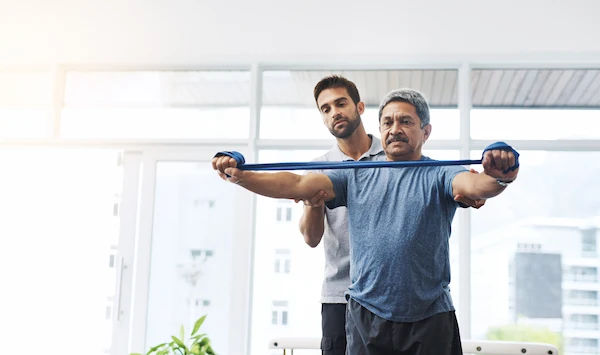How Physiotherapy Reduces Shoulder Pain?
Tired of shoulder pain? Discover how physiotherapy offers effective, non-invasive treatment to reduce pain, restore mobility, and strengthen your shoulder. Learn about common conditions and what to expect. Start your recovery today!

Written by Dr. M L Ezhilarasan
Reviewed by Dr. Rohinipriyanka Pondugula MBBS
Last updated on 24th Oct, 2025

Introduction
Shoulder pain can make simple tasks—reaching a shelf, fastening a bra, sleeping on your side—feel frustrating or impossible. The good news is that physiotherapy is one of the most effective, non-surgical ways to reduce shoulder pain, restore movement, and get you back to the activities you love. In this clear, practical guide, you’ll learn how physiotherapy helps shoulder pain, what happens at your first visit, and exactly which exercises, hands-on techniques, and daily habit changes make the biggest difference.
We’ll explain the most common causes of shoulder pain, share what current research says about exercise vs injections and surgery, and show you how to track progress so you know your plan is working. You’ll also get a sample weekly routine, sleep and workstation tips, and guidance on when to seek more help. If your symptoms persist or worsen, we’ll cover how to consult a doctor online with Apollo 24|7 for timely evaluation. Whether you’re dealing with rotator cuff–related shoulder pain, bursitis, or a frozen shoulder, this guide puts proven physiotherapy strategies in your hands—safely and step by step.
Why Your Shoulder Hurts?: Anatomy and Common Causes
The shoulder is your most mobile joint—and that mobility relies on teamwork among the ball-and-socket joint, the shoulder blade (scapula), the collarbone, and a set of stabilizing muscles called the rotator cuff. Between bones and tendons lie bursae (fluid-filled cushions) that reduce friction. When any part becomes irritated—from overload, underuse, or injury—pain and stiffness can follow.
Common diagnoses:
- Rotator cuff–related shoulder pain (often called “impingement”): Pain with overhead activity, reaching, or lying on the side. Usually due to tendon overload and poor load tolerance rather than “bones pinching tendons.” Exercise therapy and activity modification are first-line treatments.
- Subacromial bursitis: Inflamed bursa causing aching at the outer shoulder, worse with lifting. Often coexists with rotator cuff issues; responds to graded loading and, sometimes, short-term anti-inflammatories.
- Frozen shoulder (adhesive capsulitis): Marked stiffness and night pain, often in people aged 40–60 and more common with diabetes or thyroid conditions. It progresses through painful, stiff, and thawing phases; physiotherapy and, in some cases, a steroid injection shorten the painful phase.
- Osteoarthritis: Wear-and-tear changes leading to stiffness and crepitus, typically in older adults. Exercise and activity modification can reduce pain and improve function; surgery only if severe.
Instability: Recurrent slipping or dislocation, especially in athletes. Requires strengthening and control; surgery sometimes needed.
Red flags you shouldn’t ignore:
Sudden severe pain after trauma, visible deformity, fever, unexplained weight loss, chest pain, or pain radiating down the arm with neurological symptoms. Seek urgent medical attention.
Context: Shoulder pain is common—annual prevalence up to about 26%—and many cases improve with conservative care.
Consult a Top General Physician
How Physiotherapy Reduces Shoulder Pain: What the Science Says?
Physiotherapy tackles shoulder pain by reducing irritation, improving tissue capacity, and changing how your brain interprets pain. Education and reassurance lower fear, which can reduce protective muscle guarding. Gentle movement brings blood flow and nutrients, while progressive exercise rebuilds tendon and muscle capacity so everyday loads feel easier. Manual therapy can temporarily improve movement and ease pain so you can exercise better.
What the evidence shows:
- Exercise works: Cochrane reviews suggest that exercise therapy improves pain and function for rotator cuff–related shoulder pain compared with minimal care. Benefits are often medium in size and grow over weeks to months.
- Advice vs supervised exercise: The GRASP trial (Lancet, 2021) found that a high-quality advice session plus a home program can be nearly as effective at 12 months as supervised progressive exercise. The message: do the right exercises—and do them consistently.
- Injections: Corticosteroid injections can provide short-term pain relief (weeks to a few months), helping people tolerate exercise, but they do not outperform exercise over the long term. GRASP showed early benefit with injection, but no long-term advantage at 12 months.
- Manual therapy: Joint and soft-tissue techniques may offer short-term pain relief and mobility gains, especially when combined with exercise. Alone, effects are typically temporary.
- Surgery vs conservative care: For many with subacromial pain, surgery does not outperform good conservative care in the long term. This underscores the value of physiotherapy-first approaches.
A unique insight: Think of pain as a “capacity vs demand” problem. Physiotherapy increases capacity (stronger, more resilient tissues and better movement patterns) while temporarily lowering demand (smart activity modification). When the two rebalance, pain usually eases and function returns.
Your First Physio Visit: Assessment, Plan, and Goals
A thorough first visit sets the roadmap. Your physiotherapist will:
- Take a detailed history: Onset, aggravating movements, sleep patterns, work and sport demands, prior treatments, general health (e.g., diabetes risk for frozen shoulder).
- Screen for red flags and nerve involvement: Neck referral, weakness, or sensory changes.
- Examine movement: Active and passive range of motion, painful arcs, scapular movement quality, and basic strength tests (isometrics for rotator cuff and scapular stabilizers).
- Perform condition-specific tests: For example, external rotation lag for rotator cuff integrity, cross-body adduction for AC joint irritation, and capsular pattern loss for frozen shoulder.
Setting SMART goals and baselines: - Use validated measures like SPADI (Shoulder Pain and Disability Index) or QuickDASH to quantify pain and function now, and recheck every 4–6 weeks to track progress.
- Define goals that matter to you: Sleep through the night, wash hair without pain, return to gym overhead press, or swim 1 km.
When imaging or labs make sense:
- Imaging: Often not needed initially. Consider severe trauma, persistent night pain unresponsive to care, red flags, or suspected full-thickness rotator cuff tear in a high-demand patient.
- Labs: In persistent cases or where systemic factors are suspected (e.g., diabetes with frozen shoulder), tests like HbA1c or vitamin D may be appropriate. Apollo 24|7 offers convenient home collection for tests like vitamin D or HbA1c, which can be discussed with your clinician if relevant to your recovery.
If symptoms persist beyond two weeks without improvement, consult a doctor online with Apollo 24|7 for further evaluation, especially if pain is severe at night, range is rapidly worsening, or you have systemic symptoms.
The Best Exercises for Shoulder Pain—And How to Do Them?
The right exercises progress from pain-calming moves to strength and function. Quality and consistency matter more than complexity. Two long-tail terms you’ll see here: shoulder physiotherapy exercises at home and scapular stabilization exercises.
Early-phase (reduce pain, restore motion):
- Pendulums: Lean forward, let the arm dangle, and gently sway. 1–2 minutes, 2–3 times/day. Calms pain without overloading.
- Assisted range: Use a stick or opposite hand for shoulder flexion and external rotation. 10–12 reps, 2–3 sets, daily.
- Isometric holds for pain relief: Gently push into a belt or wall without moving (external rotation, internal rotation, abduction). Hold 10–20 seconds, 5–8 reps. Isometrics can reduce pain while maintaining tendon load tolerance.
Mid-phase (capacity building):
- External rotation strength: Resistance band at waist height, elbow at side, rotate outward. 3 sets of 8–12, every other day.
- Scapular control: Prone Y/T or banded scapular retraction and depression. 3 sets of 10–12.
- Elevation with control: Scaption raises (in the scapular plane) with light dumbbells, stopping before pain. 2–3 sets of 8–10.
Return-to-function and sport:
- Closed-chain: Wall slides or serratus wall taps for overhead stability.
- Plyometric/control: Medicine ball wall throws or rebounders at low volume for athletes.
- Task-specific: For swimmers, integrate catch-pull-through drills and dryland external rotation work; for workers, loaded carries and controlled overhead reaches.
A sample weekly plan:
- Mon: Isometrics + assisted range + band external rotation
- Tue: Scapular control + light scaption + pendulums
- Wed: Mobility + isometrics
- Thu: Strength progression (band ER/IR, scaption)
- Fri: Mobility + closed-chain drill (wall slides)
- Sat: Sport/task-specific (light volume)
- Sun: Restorative mobility and walk
Progress by increasing load 5–10% weekly if pain remains ≤3/10 during and after exercise and settles within 24 hours. If pain spikes, reduce volume or regress exercises.
Hands-On Therapy and Helpful Adjuncts
Manual therapy can complement exercise by easing pain and improving short-term mobility so you can train better. Two LSI terms to weave in: manual therapy for shoulder pain and isometric exercises for shoulder pain.
Joint mobilization:
Gentle glenohumeral and scapulothoracic mobilizations can improve movement more comfortably (e.g., posterior glide to assist elevation and external rotation). Particularly useful in stiff shoulders and early adhesive capsulitis. Effects are often short-term without concurrent exercise.
Soft-tissue techniques:
Myofascial release and trigger point work for upper trapezius, infraspinatus, and pectoralis minor may reduce guarding. Use as a bridge to active mobility.
Taping and bracing:
Kinesiology or rigid taping can provide positional feedback, promote scapular posterior tilt, and reduce perceived pain during tasks. Effects are typically modest but can help maintain better mechanics during healing.
Modalities—what actually helps?
- Heat/ice: Useful for symptom control; heat before exercise to relax, ice after if sore.
- TENS: Can provide temporary pain relief for some.
- Ultrasound: Limited high-quality evidence for meaningful benefit in rotator cuff–related pain; not a primary therapy.
- Shockwave: May help certain calcific tendinopathies; consider when conservative exercise is not progressing.
- The unique angle: Use modalities sparingly—as “door openers” to enable better exercise—not as stand-alone fixes.
Posture, Ergonomics, Sleep, and Daily Habits
Your shoulder doesn’t live in isolation—how you sit, reach, carry, and sleep can either aggravate or accelerate healing. Two long-tail terms to naturally include: posture and shoulder pain, shoulder pain at night sleeping position.
Workstation and “movement-rich” days:
- Keyboard and mouse close, elbows at ~90°, screen at eye level.
- Alternate tasks every 20–30 minutes; set a timer for 60-second microbreaks: stand, shoulder rolls, scapular squeezes (10 reps).
- Use a headset for long calls to avoid protracted arm positions.
Lifting, reaching, overhead strategies:
- Keep objects close to your body, especially when lifting to or lowering from shelves.
- Prefer two hands for overhead tasks; step onto a small stool to reduce end-range strain when placing items high.
- For gym-goers: During the rehab phase, swap painful overhead presses for landmine presses or incline pressing; emphasize controlled tempo and comfortable ranges.
Sleep positions:
- Side sleeping: Lie on the non-painful side. Place a pillow in front to support the painful arm, slightly elevated, with the elbow bent.
- Back sleeping: Use a small pillow under the upper arm to keep the shoulder neutral.
- Avoid sustained end-range positions that compress the front of the shoulder. If night pain persists, consult your clinician; sometimes adjusting the evening routine (heat, gentle mobility, isometrics) reduces flare-ups.
Daily habit unique insight:
Micro-loading beats mega-rest. Completely “resting” can decondition tissues. Instead, keep moving within a pain-guided limit—motion nourishes joints and helps the nervous system downshift pain sensitivity.
Progress, Prevention, and When to Seek More Help
Milestones and plateaus:
Expect gradual change over 6–12 weeks with consistent exercise. Reassess SPADI/QuickDASH every 4–6 weeks to confirm improvements in pain and function. If your scores plateau for two consecutive checks, re-evaluate your plan.
When to escalate care?:
- Consider a medical review if pain is severe at night, range is rapidly decreasing, or function worsens despite 4–6 weeks of good adherence. Corticosteroid injection may help short term rotator cuff–related shoulder pain or frozen shoulder to enable better exercise.
Imaging (ultrasound/MRI) may be warranted if a full-thickness rotator cuff tear is suspected, after significant trauma, or if surgery is being considered.
If your condition does not improve after trying these methods, book a physical visit to a doctor with Apollo 24|7 or consult a doctor online for timely guidance and a potential referral pathway.
Prevention and a 10-minute maintenance routine:
- 3 minutes: Mobility (assisted flexion and external rotation).
- 4 minutes: Strength (band external rotation, scapular retraction).
- 3 minutes: Posture resets (wall angels, chin nods) and breathing to reduce upper-trap tension.
- Add load thoughtfully: Increase volume or intensity by 5–10% per week. Anchor all progressions to good symptom behavior (no more than 3/10 pain during, back to baseline within 24 hours).
Conclusion
Shoulder pain is common—and very often, fixable—without surgery. Physiotherapy reduces shoulder pain by calming irritated tissues, restoring mobility, and progressively rebuilding strength and confidence so everyday loads feel easier. Research shows that doing the right exercises consistently is the key predictor of success. Hands-on techniques, taping, and simple modalities can make exercise more comfortable, while small daily habit changes—how you sit, reach, lift, and sleep—keep symptoms from flaring.
Your plan should be personal: start with pain-calming movement, add targeted strength, and progress toward your life or sport goals. Track how you feel and function using a simple score like SPADI or QuickDASH. If progress stalls or night pain persists, it’s reasonable to consider a medical review or a short-term injection to help you participate in rehab. If your condition does not improve after trying these methods, book a physical visit to a doctor with Apollo 24|7 or consult a doctor online to tailor next steps. Apollo 24|7 also offers convenient home collection for tests like vitamin D or HbA1c when these factors are clinically relevant.
Bottom line: With a clear plan and steady effort, physiotherapy can help you reduce shoulder pain, sleep better, and return to the activities you enjoy—safely and with confidence.
Consult a Top General Physician
Consult a Top General Physician

Dr. Praveen Kumar Mukka
General Physician/ Internal Medicine Specialist
21 Years • MBBS, MD General Medicine
Hyderabad
Apollo 24|7 Clinic - Telangana, Hyderabad
(50+ Patients)

Dr. Rajib Ghose
General Physician/ Internal Medicine Specialist
25 Years • MBBS
East Midnapore
VIVEKANANDA SEBA SADAN, East Midnapore

Dr. Swagato Podder
General Practitioner
5 Years • MBBS
Kolkata
GRD POLYCLINIC, Kolkata

Dr Chilukuri Venkata Reddy
General Physician
4 Years • MBBS
Bengaluru
PRESTIGE SHANTHINIKETAN - SOCIETY CLINIC, Bengaluru
Dr. Abhishek Gowda
General Physician/ Internal Medicine Specialist
2 Years • MBBS
Bengaluru
PRESTIGE SHANTHINIKETAN - SOCIETY CLINIC, Bengaluru
Consult a Top General Physician

Dr. Praveen Kumar Mukka
General Physician/ Internal Medicine Specialist
21 Years • MBBS, MD General Medicine
Hyderabad
Apollo 24|7 Clinic - Telangana, Hyderabad
(50+ Patients)

Dr. Rajib Ghose
General Physician/ Internal Medicine Specialist
25 Years • MBBS
East Midnapore
VIVEKANANDA SEBA SADAN, East Midnapore

Dr. Swagato Podder
General Practitioner
5 Years • MBBS
Kolkata
GRD POLYCLINIC, Kolkata

Dr Chilukuri Venkata Reddy
General Physician
4 Years • MBBS
Bengaluru
PRESTIGE SHANTHINIKETAN - SOCIETY CLINIC, Bengaluru
Dr. Abhishek Gowda
General Physician/ Internal Medicine Specialist
2 Years • MBBS
Bengaluru
PRESTIGE SHANTHINIKETAN - SOCIETY CLINIC, Bengaluru
More articles from Shoulder Pain
Frequently Asked Questions
What are the best shoulder physiotherapy exercises at home for early pain?
Gentle pendulums, assisted range (stick or towel), and isometric holds for external/internal rotation reduce pain while maintaining load tolerance. Keep pain ≤3/10 and progress gradually.
How long does frozen shoulder physiotherapy treatment take?
Many improve over months, but frozen shoulders can take 12–18 months to fully resolve. Physiotherapy plus a corticosteroid injection may shorten the painful phase for some. If symptoms persist beyond two weeks without any improvement, consult a doctor online with Apollo 24|7.
Do I need imaging before starting shoulder impingement exercises?
Usually no. Guidelines suggest starting with exercise-based care unless there’s trauma, severe weakness, or red flags. Imaging is considered if symptoms persist or surgery is contemplated.
Are corticosteroid injection vs physiotherapy shoulder outcomes different?
Injections can reduce pain sooner (weeks), but physiotherapy provides comparable or better outcomes long-term. Many benefit from combining a short-term injection with a structured exercise plan.
What sleep position helps shoulder pain at night?
Try side-lying on the non-painful side with the painful arm supported on a pillow, or on your back with a small pillow under the upper arm. Adjust your evening routine (heat, gentle mobility)

